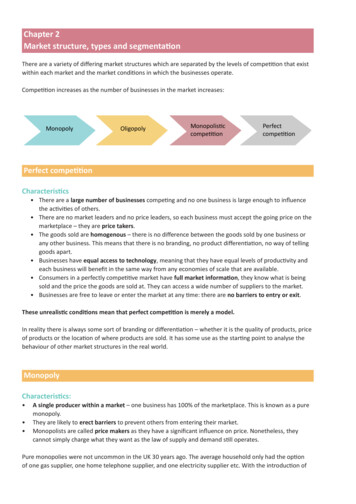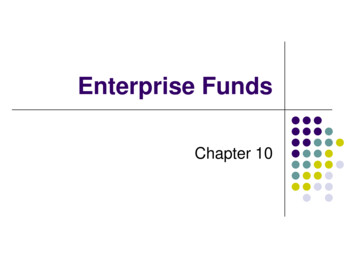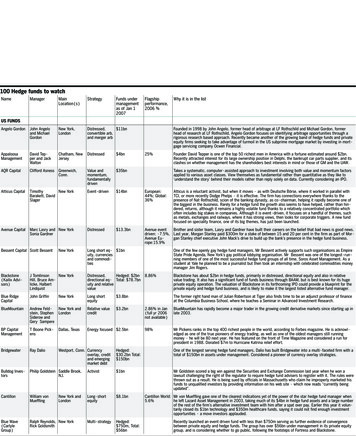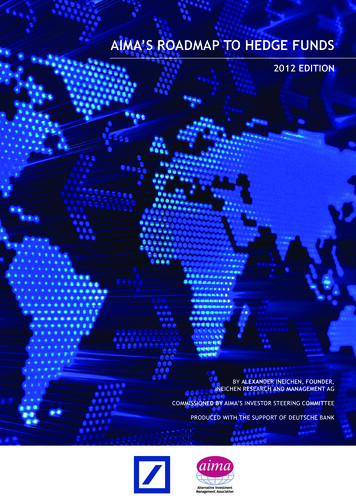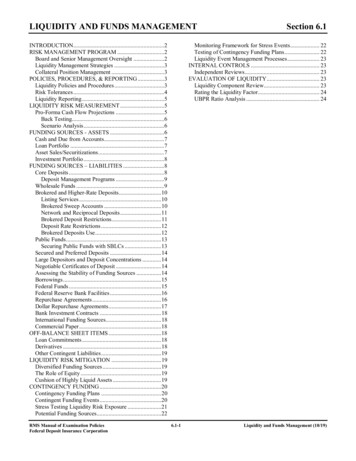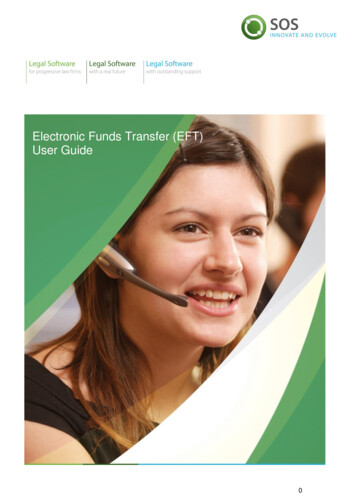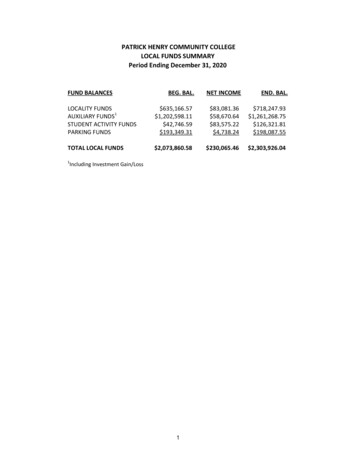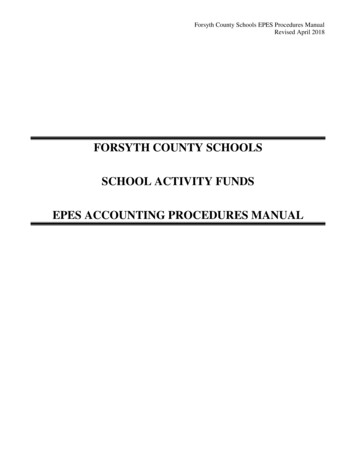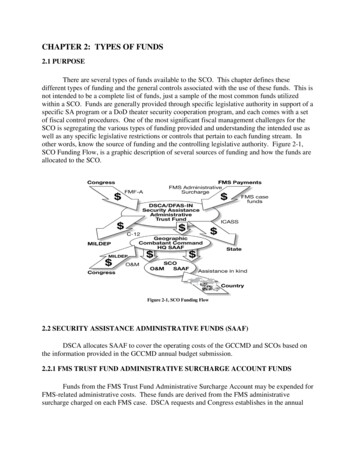
Transcription
CHAPTER 2: TYPES OF FUNDS2.1 PURPOSEThere are several types of funds available to the SCO. This chapter defines thesedifferent types of funding and the general controls associated with the use of these funds. This isnot intended to be a complete list of funds, just a sample of the most common funds utilizedwithin a SCO. Funds are generally provided through specific legislative authority in support of aspecific SA program or a DoD theater security cooperation program, and each comes with a setof fiscal control procedures. One of the most significant fiscal management challenges for theSCO is segregating the various types of funding provided and understanding the intended use aswell as any specific legislative restrictions or controls that pertain to each funding stream. Inother words, know the source of funding and the controlling legislative authority. Figure 2-1,SCO Funding Flow, is a graphic description of several sources of funding and how the funds areallocated to the SCO.Figure 2-1, SCO Funding Flow2.2 SECURITY ASSISTANCE ADMINISTRATIVE FUNDS (SAAF)DSCA allocates SAAF to cover the operating costs of the GCCMD and SCOs based onthe information provided in the GCCMD annual budget submission.2.2.1 FMS TRUST FUND ADMINISTRATIVE SURCHARGE ACCOUNT FUNDSFunds from the FMS Trust Fund Administrative Surcharge Account may be expended forFMS-related administrative costs. These funds are derived from the FMS administrativesurcharge charged on each FMS case. DSCA requests and Congress establishes in the annual
Foreign Operations, Export Financing, and Related Programs Appropriations Act an obligationauthority ceiling for each fiscal year.2.2.2 FOREIGN MILITARY FINANCING (FMF) ADMINISTRATIVE FUNDSFMF administrative funds are appropriated as part of the overall FMF program in theannual Foreign Operations, Export Financing, and Related Programs Appropriations Act. Thesefunds are made available by Congress to support specified SA program management functions,as defined in Foreign Assistance Sections 515 and 516 (e.g., IMET, Enhanced End UseMonitoring (EEUM), grant Excess Defense Articles (EDA).2.2.3 SCO OPERATIONAL FUNDSThe combination of FMS Trust Fund Administrative Surcharge Account funds and FMFAdministrative funds, allocated by DSCA for the administrative costs of SCOs are genericallydesignated as security assistance administrative funds (SAAF). For GCCMD and SCO purposes,the funds allotted make no distinction as to the amount of FMS Trust Fund AdministrativeSurcharge Account and FMF administrative funds provided. The Defense Finance andAccounting Service (DFAS) and DSCA provide the required departmental reporting for thesefunds.2.2.4 REPRESENTATIONAL AUTHORITY (REP)2.2.4.1 REP authority will be used to maintain the standing and prestige of the UnitedStates by extending official courtesies to certain dignitaries and officials of the United States andforeign countries. The SDO/DATT or designee may obligate REP only for official entertainmentor other official purposes authorized in Department of Defense (DoD) Instruction 7250.13,Use of Appropriated Funds for Official Representation Purposes. The GCCMD and DSCAmust approve exceptions in advance, and in writing. All official entertainment must beappropriate to the occasion and, in all instances, must be conducted on a modest basis.2.2.4.2 REP authority may be expended for the official entertainment and/or purchase ofpresentation gifts for authorized guests, to include civilian or military dignitaries and officials offoreign governments, senior U.S. Government officials, dignitaries and senior officials of stateand local governments, and other distinguished and prominent citizens who have madesubstantial contribution to the U.S. or the DoD in a security assistance capacity.2.2.4.3 DSCA will allocate annual REP authority to each GCCMD in the FundsAuthorization Document (FAD). The GCCMD will, in turn, issue authority to the SCO. Theauthority cannot be exceeded without advance, written approval of the GCCMD. If the GCCMDrequires additional authority, they can make a request to DSCA/CMP in advance, and in writing.The limitation provided is only authority, not additional funding and is provided forrepresentational purposes only.2.2.4.4 The GCCMD total annual REP authority is issued by DSCA/CMP in theapproved SCO Annual Funding Plan. SCO REP authority issued by the GCCMD is part of the
worldwide limitation established by law. The GCCMD authority may not be exceeded withoutthe written approval of DSCA. Anticipated REP expenses will be included as part of theoperating budget request for each SCO.2.2.5 GCCMD HQ SAAFDSCA/CMP allocates SAAF to the GCCMD HQ to support SA program managementoversight activities. These SAAF supports both FMS and non-FMS activities (e.g., FMF, EUM,and IMET). The GCCMD may transfer funds between SCO and HQ accounts after receivingwritten DSCA/CMP approval.2.2.6 FMS CASE FUNDS2.2.6.1 Special programs within a country may be supported directly through the use ofFMS case funds when the Host Nation establishes a case to fund the costs of a specificrequirement. Examples of case-funded activities involve Technical Assistance Field Teams(TAFTs), Mobile Training Teams (MTTs), or Mobile Education Teams (METs).2.2.6.2 The costs of the personnel assigned to these teams including any overheadexpenses (e.g., International Cooperative Administrative Support Services (ICASS) – discussedin Chapter 6) must be charged directly to the FMS case. The MILDEP case manager isresponsible for the management of these funds. Each FMS Case must have a separate ICASSagreement established and in place prior to the deployment of a mobile training team or othercase funded, in-country personnel.2.2.6.3 Case funds may be provided to the SCO to support in-country expenses directlyrelated to a case. The MILDEP case manager is required to provide instructions for the use ofsuch funds in the case implementing directive and ensure the funds are cited on all travel ordersof deployed team members. Case funds are not typically monitored by DSCA unless there areunique circumstances; applicable expenses under the local cognizance of the TAFT or MTT leadmay be tracked in Security Assistance Automated Resource Management Suite (SAARMS) toperform memorandum reporting to the case manager. The case manager is responsible for theoverall case financial management and reconciliation.2.2.6.4 A frequent use of case funds is TDY associated to a specific program. SCOpersonnel traveling at the request and in support of a specific FMS program, (e.g., attendance atan F-16 Program Management Review), must use case funds. The SCO should request fundsfrom the case manager; the use of SAAF for specific case tasks is not an appropriate use ofSAAF.2.2.6.5 SCOs must insure that costs supporting FMS cases and case funded personnel arecharged to the case and not to the SCO SAAF. This requires a separate ICASS supportagreement as well; therefore, close coordination with U.S. Embassy financial staff is essential.
2.2.7 O&M APPROPRIATED FUNDS2.2.7.1 Funds appropriated by Congress to the MILDEPs support the day-to-dayoperations of U.S. Forces may also be made available to the SCO for non-SA requirements. Thefunds are managed in accordance with the governing regulation(s). The SAARMS BudgetExecution Application can provide memorandum accounting for these funds.2.2.7.2 DoD O&M funds are usually restricted to a specific use for a specific period oftime and require separate management from other SCO funds. Some examples are: O&M funds for specific non-SA functions or billets, e.g., Humanitarian Assistanceprojects, Defense Cooperation in Armaments Programs, Traditional CombatantCommander Activities, peace time theater security cooperation activities (e.g.,exercises and ship/aircraft visits), and MILDEP exchange personnel. MILDEP appropriations for specific administrative and logistics functions asspecified in AR 1-75/SECNAVINST 4900.49. Examples include travel by SCOpersonnel to a MILDEP required medical examination or a retirement seminar. MILDEP appropriations may also be used for specific costs, such as theadministrative and logistical support for non-SA billets assigned to a SCO. Non-appropriated funds (NAF) for morale, welfare, and recreation (MWR) supportfor SCO assigned personnel.2.2.7.3 The GCCMD must require the SCO to prepare budgets for each type of funds, toinclude the SCO SA budget. The SAARMS Budget Preparation Application can accommodatethe submission of budgets for various types of funding, not just SAAF requirements.2.2.8 ASSISTANCE IN KIND (AIK)AIK is generally non-monetary support that a Host Nation provides the SCO under abilateral agreement(s). Typical non-monetary support may be office space, transportation,utilities, and personnel. While not a funded program, AIK must be annotated in the SCO budgetsubmission. In the event that AIK support is reduced or terminated, the level of required supportwould then be included in the appropriate funding source(s) budget submission documents.2.2.9 SPECIAL DEFENSE ACQUISITION FUND (SDAF)2.2.9.1 The SDAF is used as a revolving fund separate from other accounts, to financethe acquisition of defense articles and services in anticipation of their transfer to eligible foreigncountries and international organizations.
2.2.9.2 This provides the DoD with the flexibility required in planning for anticipatedforeign procurements of U.S. defense materiel. Through its ability to buy military equipment tomeet future requirements, the SDAF permits the U.S. to act in anticipation of an emergingdefense export environment.2.2.9.3 The objective of SDAF is to procure high demand, long-lead time defenseequipment in anticipation of future sales to be conducted on a government to government basisthrough the FMS Program. These acquisitions result in accelerated delivers once FMSagreements are signed. The availability of SDAF assets reduces pressure on the DoD to meeturgent requirements through withdrawals from U.S. inventories or through diversions fromproduction.2.2.10 CAPITAL SECURITY COST SHARING (CSCS)CSCS is DoS legislative authority to fund the construction of new U.S. Embassies andConsulates worldwide. It authorizes the Secretary of State to determine the cost share for eachtenant agency under the control of the COM and is designed to generate 17.5 billion over a 14year period or 1.4 billion annually. It is authorized by Section 604 of the Secure EmbassyConstruction and Counterterrorism Act of 1999, as amended by the FY 2005 ConsolidatedAppropriations Act (P.L. 108-447). CSCS is also designed as an incentive for all tenant agenciesto right size their overseas staff to reflect the number of essential personnel for missionaccomplishment. Annually, DoS assesses its embassy tenants a per capita cost per assignedindividual by location in the Embassy. Positions located in a controlled access area (CAA) arecharged more than double the cost of being located outside a CAA. SCOs that are not colocated in the Embassy, but are located in a Host Nation facility, such as its Ministry of Defense,should not incur any CSCS charges. Each GCCMD and SDO/DATT should strive forefficiencies in staffing levels and in reducing their CAA footprint.2.3 SUMMARYIt is important to identify and understand the various sources of SCO funding and toensure the proper application of each source, keeping in mind that each funding category comeswith rules, regulations, and potential restrictions. It is also paramount for each SCO to ensurethe proper oversight, management, usage, and tracking of funds.
CHAPTER 2: TYPES OF FUNDS 2.1 PURPOSE There are several types of funds available to the SCO. This chapter defines these different types of funding and the

